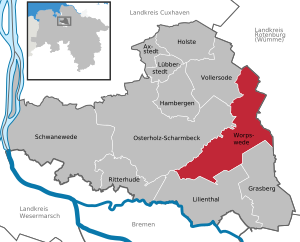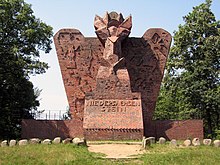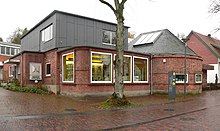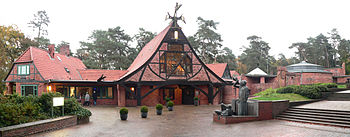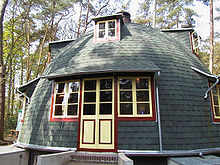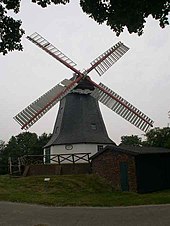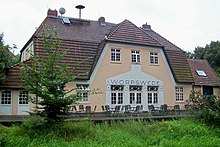Worpswede
| coat of arms | Germany map | |
|---|---|---|

|
Coordinates: 53 ° 13 ' N , 8 ° 56' E |
|
| Basic data | ||
| State : | Lower Saxony | |
| County : | Osterholz | |
| Height : | 20 m above sea level NHN | |
| Area : | 76.14 km 2 | |
| Residents: | 9494 (Dec. 31, 2019) | |
| Population density : | 125 inhabitants per km 2 | |
| Postal code : | 27726 | |
| Primaries : | 04792, 04794 | |
| License plate : | OHZ | |
| Community key : | 03 3 56 011 | |
| LOCODE : | DE WRP | |
| Community structure: | 8 parts of the community | |
| Address of the municipal administration: |
Farmers row 1 27726 Worpswede |
|
| Website : | ||
| Mayor : | Stefan Schwenke ( independent ) | |
| Location of the community Worpswede in the district of Osterholz | ||
Worpswede ( Low German Worpsweed ) is a municipality in the Osterholz district in Lower Saxony , on the Hamme northeast of Bremen , in the middle of the Teufelsmoor , and a state-approved resort. The place is on the 54.4 meter high elevation of the Weyerberg , which towers above the flat surroundings. The first traces of settlement go back to the Bronze Age .
The place is known for the Worpswede artists' colony as a living and working community of artists. The Künstlerhäuser Worpswede scholarship institution was one of the largest in Germany until 2009. There are numerous cultural institutions and galleries in Worpswede.
geography
Community structure and incorporations
Originally there were 23 villages in the area of today's unified municipality of Worpswede, each of which formed its own municipality. In the 1920s and 1936 numerous parishes were merged, so that the number was reduced to eight. On March 1, 1974, the other seven were incorporated into Worpswede. These eight former municipalities now form the localities of Worpswede:
- Worpswede (with Bergedorf , Nordwede , Südwede , Weyerdeelen , Weyermoor , Wörpedahl and Worpheim )
- Hüttenbusch (with Fünfhausen , Heudorf and Hüttendorf )
- Mevenstedt
- New Sankt Jürgen
- Ostersode (with Meinershagen and Nordsode )
- Schlussdorf
- Over the top
- Waakhausen (with Viehland )
Neighboring communities
Neighboring communities of Worpswede are in the northeast the community Gnarrenburg , in the east the communities Breddorf , Hepstedt and Tarmstedt belonging to the integrated community Tarmstedt , in the south the communities Grasberg and Lilienthal , in the west the city Osterholz-Scharmbeck and in the northwest the community Vollersode belonging to the combined community Hambergen .
history
middle Ages
In the 11th century a fishing settlement was founded on the property of the Osterholz monastery. The first written mention of the place was in 1218.
From 1600 to 1750
During the Thirty Years War Worpswede was ruled from 1627 by the Catholic imperial troops of the Archbishopric of Bremen . In 1630 the Swedes took over military power in the area around Worpswede. In 1648 Worpswede was finally ceded to Friedrich von Hessen-Eschwege .
From 1750 to 1850
On behalf of the Elector of Hanover , Jürgen Christian Findorff began the extensive drainage and colonization of the Teufelsmoor around 1750, which also resulted in the places Heudorf (1756, today Heudorfer Straße), Hüttendorf (1776, today Hüttendorfer Straße) and Schlussdorf (1800). The village of Nordwede, founded in 1764 and populated with 13 cultivation sites, was popularly known as "Sniederdorp" (tailor village) because the first settler was a tailor.
From 1850 until today
The Worpswede artists' colony was founded in 1889 .
National Socialism also hit the ground in Worpswede. In the Reichstag election in March 1933 , 66 percent of the votes in Worpswede went to the NSDAP and the black-white-red battle front (comparative value for the entire German Reich: 52 percent). The Social Democrats and Communists , on the other hand, received only 16 percent (comparative value: 31 percent). This development was significantly reinforced in Worpswede by the homeland and nature cult of the Worpswede artists, first and foremost Fritz Mackensen , Carl Uphoff and Martha Vogeler (née Schröder), who paid homage to the nationalist idea and offered themselves to the National Socialists, while left-wing politicians like Heinrich Vogeler and Gustav Regulator , who had married Vogeler's daughter Marie, were forced to emigrate. The homeland and nature cult ultimately went back to "the great conservative national current of German intellectual history", "at the beginning of which Herder and the Romantics stand", as the Low German linguist Claus Schuppenhauer writes and became the "perversion of unconditional belief in race, Blood and soil ”, so Strohmeyer / Artinger / Krogmann in their study from the year 2000. A special insight into the situation and expulsion of Jewish residents is offered by Anning Lehmeniek's“ Jews in Worpswede ”
The Worpswede district has been a state-recognized resort since November 9, 1976 .
Population development
| Parish 1910 |
Inhabitants 1910 |
Inhabitants 1939 |
|---|---|---|
| Bergedorf | 413 | 2706 |
| Nordwede | 81 | |
| Ostendorf | 365 | |
| Osterwede | 209 | |
| Südwede | 106 | |
| Weyerdeelen | 67 | |
| Weyermoor | 66 | |
| Woerpedahl | 46 | |
| Worpheim | 145 | |
| Worpswede | 813 | |
| Funfhausen | 32 | 909 |
| Heudorf | 284 | |
| Hüttenbusch | 333 | |
| Hut village | 167 | |
| Mevenstedt | 171 | 211 |
| New St. Jürgen | 419 | 437 |
| Meinershagen | 121 | 321 |
| North Sode | 87 | |
| Ostersode | 155 | |
| Schlussdorf | 291 | 225 |
| Over the top | 186 | 181 |
| Cattle land | 60 | 102 |
| Waakhausen | 122 |
politics
| Party / list | Seats |
|---|---|
| CDU | 9 |
| SPD | 7th |
| UWG | 6th |
| LEFT | 1 |
| FDP | 1 |
Municipal council
The council of the municipality of Worpswede consists of 24 council women and councilors. This is the specified number for a municipality with a population between 9,001 and 10,000. The 24 council members are elected by local elections for five years each. The current term of office began on November 1, 2016 and ends on October 31, 2021. For the results of the local elections on September 11, 2016, see table.
The full-time mayor is also entitled to vote in the council of the municipality.
mayor
The full-time mayor of the municipality of Worpswede has been the non-party lawyer Stefan Schwenke since 2001, last re-elected in 2014 as incumbent unopposed candidate with 80.5% of the vote and a turnout of 49.3%. Schwenke began his further term in office on November 1, 2014.
coat of arms
| Blazon : “ White shield . In the base of the shield there is a green three-tiered mountain , in the mountain there is a red shield with a silver border . In this shield there are three more white shields. The red shield main shows a silver lily , both sides accompanied by four square arranged golden half-timbered houses . " | |
| Justification of the coat of arms: The coat of arms reflects the history of Worpswede: In 1223 Heinrich Duke of Saxony and Count Palatine of the Rhine donated four hooves to the Osterholz monastery. Around 1225, Margravine Margarethe von Brandenburg donated the property of half the island of Worpswedes from four Hufen to the church in Osterholz. These eight Worpsweder Höfe are shown in the shield head in gold as houses on a red background, divided with the lily. The symbol for the Marienkloster Osterholz. The eight courtyards also symbolize the eight villages in the Worpswede community. The representation of the Weyerberg is set off from the shield head in green by means of silver. The discovery of Worpswede for art by Fritz Mackensen in 1884 is anchored in the Weyerberg by the guild coat of arms of the painters separated by a silver border. The shields depicted in the painters' guild coat of arms should relate to the three arts of architecture, painting and sculpture. |
Community partnerships
Worpswede is represented in the Lower Saxony / Bremen municipal association.
Religions
The majority of the inhabitants of Worpswede belong to the Evangelical Lutheran regional church of Hanover . The citizens of the Roman Catholic faith are organized in the Holy Family parish in Osterholz-Scharmbeck, including the Maria Frieden chapel in Worpswede . There are also other Christian groups and free churches , for example a Baptist , a Brethren and a New Apostolic congregation , members of Islam and a growing group of non-denominationalists.
Culture and sights
Niedersachsenstein
The Niedersachsenstein , an 18-meter-high brick monument on the Weyerberg , looks like an eagle from a distance and is a reminder of the soldiers from the region who fell in World War I. It was completed in 1922 based on a design by the architect Bernhard Hoetger , who also designed Böttcherstraße in Bremen , and is the only large-scale expressionist sculpture in Germany of particular importance in terms of art history. Since the construction of the Lower Saxony Stone took place in a time of great poverty and food shortages, it was controversial at the time, as it is today because of its originally intended function as a war memorial.
Barkenhoff
The Barkenhoff (Low German Birkenhof ) - originally a Worpswede farm - was bought by the artist Heinrich Vogeler in 1895 and converted into an impressive Art Nouveau building within a few years . Soon he became the center of the Worpswede artist movement and thus the entire “Worpswede artist colony”. After the First World War , the Barkenhoff became the Barkenhoff municipality and work school in 1919, and from 1923 until it was closed in 1932, it became a children's home run by the Rote Hilfe .
In 1932 the Barkenhoff was sold to the garden architect and anthroposophist Max Karl Schwarz (1895–1963), who came to Worpswede through the life reformer Leberecht Migge . There he founded the Worpswede Horticultural and Settlement School together with the engineer Martin Schmidt (1892-1964) between 1932 and 1936 , where biodynamic work was taught and researched with anthroposophically oriented teachers. Schwarz is considered a pioneer of biodynamic agriculture and horticulture, composting, and a developer and promoter of the Gärtnerhof idea. In 1954, Schwarz designed the landscape park at the Goetheanum in Dornach .
In the following years the farm fell into disrepair and was handed over to the public sector in 1981. In 2003/2004 the farm was completely renovated. Since then it has served as a museum and as a space for exhibitions. Until the end of 2009, the adjoining remises served as studios for the Barkenhoff Foundation scholarship holders .
House in the shoe
Haus im Schluh, originally a moor cottage from the moor village of Lüningsee, was moved into Schluh in 1920 by Martha Vogeler , Heinrich Vogeler's first wife, and converted with his financial help. At this time she left the Barkenhoff and moved with her three daughters Marieluise, Bettina, Martha and her friend Ludwig Bäumer into the house in the Schluh (Low German swamp ). Today it consists of three thatched-roof houses: Martha Vogeler's house, the hand-weaving mill (the house was moved from Grasdorf to Schluh in 1937 and was the work area of the daughter Bettina), and the smallest house is now a guest house. In the house and the weaving mill, furniture, paintings, etchings, porcelain and household items from the Barkenhoff form the main part of the Heinrich Vogeler collection. Changing exhibitions on Heinrich Vogeler's work and handicrafts from the region complete the collection.
Worpsweder Kunsthalle
The local master bookbinder Friedrich Netzel made his shop and adjacent rooms available to the first Worpswede artists for exhibition and sales purposes. His son, Friedrich Netzel (II), set up his own house on Bergstrasse in 1919 as a gallery to exhibit contemporary art. In addition to the art trade, an art collection was created. After the gallery owner's death in 1945, his wife continued the business in the difficult post-war years and finally handed it over to his son Friedrich Netzel (III). In addition to its own family collection from three generations, it also showed special exhibitions that gave Worpswede supraregional importance. For example, in the exhibitions in 1972, 1973 and 1989 he showed Heinrich Vogeler's complete oeuvre with the works from his Soviet era, which were shown for the first time, the first major exhibition in Worpswede on Paula Modersohn-Becker on the occasion of her 100th birthday in 1976 and an exhibition on the 100th Celebration of the artist village in 1989.
After the death of the gallery owner and collector Friedrich Netzel, a foundation was established at his request to preserve the art collection in the future. Since 1999 the "Worpsweder Kunststiftung Friedrich Netzel" has been run by a team of employees and volunteers on a private basis. The collection of the Worpsweder Kunsthalle includes works by Fritz Mackensen , Otto Modersohn , Hans am Ende , Fritz Overbeck , Heinrich Vogeler and an extensive permanent loan of the work of her contemporary Ottilie Reylaender . The second generation of artists is represented by, for example, Georg Tappert , Albert Schiestl-Arding , Udo Peters , Alfred Kollmar , Tetjus Tügel , Bram van Velde , Lisel Oppel and Richard Oelze . Contemporary Worpswede artists such as Friedrich Meckseper , Heini Linkshänder and Uwe Hässler are also on display.
Coffee Worpswede
The Cafe Worpswede is an expressionist building located at the foot of the Weyerberg. It is part of a brick ensemble, which also includes the Great Art Show , and has served as a café and restaurant since 1925. A hotel was attached to the café until the 1970s. It is popularly known as "Café Crazy" because the architect, builder and artist Bernhard Hoetger began to build a house without sensible architectural drawings and without right angles - when the Worpsweders saw this, they said "dei is crazy, de guy" - and the nickname has existed ever since. Originally Hoetger, who raised an estimated 100,000 Reichsmarks for the project, offered his own creative creations here. In 2002 the café was renovated by the German Foundation for Monument Protection; important details were reconstructed. The café has been closed since the beginning of 2019.
Big art show Worpswede
The Great Worpswede Art Show is part of the expressionist brick ensemble at the foot of the Weyerberg, which also includes the Worpswede café. In a permanent exhibition it shows a partly changing selection of pictures by Worpswede artists. In 2008 the Great Art Show Worpswede reopened after renovation measures; The renovated and expanded former Roselius Museum from 1971 next to the Kunstschau building, including a newly constructed, glass connecting wing, has functioned as a house for contemporary and modern art since 2011.
Museum at the Modersohn House
The Museum am Modersohn-Haus shows the former home of the painters Otto Modersohn and Paula Modersohn-Becker at Hembergstrasse 19. It shows pictures by Modersohn-Becker and some of the original furniture. The modern extension serves to exhibit works by other painters of the first Worpswede generation of painters.
Bonze of humor
The bonze of humor is a laughing Buddha statue that stands near the parking lot at Cafe Worpswede . The stone monument - like the café and the Niedersachsenstein - was designed by Bernhard Hoetger in 1914. The statue emerged from a series of 15 small majolica ceramics. When Hoetger was still active on the Mathildenhöhe in Darmstadt, he created a cycle of pairs of opposites. With them he wanted to represent the “light and dark sides” of humans. B. Goodness, faith, hope on the light side, greed, anger, hatred on the dark side. The bonze formed the central figure on the light side (that's why it is actually called light). The anger as part of the dark side - also made of artificial stone - is only a few steps away next to the staircase to the large art show. Both were initially set up by Hoetger in the park of his first residence in Worpswede, the Brunnenhof. There they were given the names Orang and Utan by the Worpswedern. The Brunnenhof burned down in 1923 and a new building was erected in its place in 1924, which the owner named Diedrichshof after her husband's first name . The house has belonged to the Bremer Heimstiftung since 1953. The garden with numerous sculptures, which was later named Hoetger Garden in honor of the artist, has been preserved and restored . Some still images, like the fat cat, have been moved to other locations.
Stolte department store
The department store Stolte on Findorffstraße is the oldest shop in the village with a tradition going back almost 200 years. It was created in 1824. A grandson of the first Worpswede pastor had it built after he had given up his grocer's shop in the pastor's barn below the church. Many churchgoers used the house as relaxation and for Sunday shopping. It is thanks to the Stolte family of merchants, especially their daughter Emilie (Mimi) Stolte, that Worpswede rose from an insignificant moor village to a world-famous artists' colony. In 1884, Mimi Stolte invited the art student Fritz Mackensen , whom she had met in Düsseldorf, to her parents' house. A first visit turned into several, and finally from 1889 a permanent stay after Mackensen had joined a few painter friends who formed the core of the artist colony. A text board and a portrait of Mackensen next to the house entrance refer to this story.
Cheese bell
The Worpsweder cheese bell is a dome-shaped building on the Weyerberg and was built in 1926 by the writer Edwin Koenemann. In 1921 , the architect Bruno Taut published drafts for the Central German Exhibition for Settlement and Work in Magdeburg in the magazine Frühlicht . A studio house that was adapted here by Koenemann was also presented.
Zionskirche and church cemetery
The Zionskirche on the Weyerberg was built in the middle of the Seven Years' War between 1757 and 1759. On the basis of plans by the Hanoverian court architect Johann Paul Heumann , the bog colonizer Jürgen Christian Findorff directed the construction work. Financial support came from the Elector of Hanover and King of England, George II. The pulpit altar with some Rococo ornaments stands out from the simple furnishings of the hall church. Noteworthy are angel putti under the gallery ceiling and flower ornaments in the spandrels of the pillars on the galleries. They are "detentions" by the art students at the time, Clara Rilke-Westhoff and Paula Modersohn-Becker. Both had illegally rang the church bells in 1900, which was misinterpreted as a fire alarm. In 1762 Dietrich Christoph Gloger created an organ that has not been preserved, but was reconstructed by Hendrik Ahrend in 2011/12 based on Gloger's concept. The new organ has 22 registers . The church tower with its widely visible white collar below the baroque spire was not added on the east side until 1798. Like the entire church, it served the painters of the Worpswede artists' colony as a coveted motif.
The cemetery, planned and set up by Findorff, is still a real cemetery. With its beautiful location and design, it is the destination of many visitors. About 80 important painters, writers, musicians and craftsmen have found their final resting place on it. Among them are the discoverer Worpswedes as an artist village, Fritz Mackensen, and Paula Modersohn-Becker.
The tomb created by the sculptor, designer, painter and architect Bernhard Hoetger between 1916 and 1919 for the painter Paula Modersohn-Becker , who died early in 1907 , has a special attraction for many people who visit the Worpswede cemetery. The monument is dominated by a half-bared, recessed, life-size female figure made of cast stone. A small, naked child is sitting on her lap with an apple in her hands. The depiction is intended to express the fate of the painter, who died a few days after the birth of her only daughter, and symbolize the cycle of growth and decay.
Windmill
On the outskirts of Worpswede on the way to Hamme, there had been a post mill since 1701 , which had only one rye meal. In 1838 it was replaced by the Erd- and Wallholländer, which is still fully functional today . This new and larger mill was equipped with three grinding aisles, a rye, a wheat and a barley aisle. In 1888 the mill (until today in the sixth generation) came into the possession of the miller family Schwenke. In order to survive in the increasingly tough competition, it has been overhauled several times and its technology has been adapted to the latest technical standards, including a. Conversion from sail gate to venetian blinds, installation of motors and a wind rose. Since the end of business in 1986, the Friends of Worpswedes e. V. the mill. Worpswede's landmark has always served the painters as a motif.
New Helgoland observation tower
The nine-meter-high Neu-Helgoland observation tower is about 2.5 km west of Worpswede on the northern bank of the Hamme, just before the tributary of the Beek , not far from Neu-Helgoland . After the observation towers An den Postwiesen and In den Linteler Weiden near Osterholz-Scharmbeck, it was built at the end of 2014 as the third observation tower as part of the GR project Hammeniederung in an idiosyncratic form made of steel and offers a good view of Worpswede, the Weyerberg and nature and the surrounding landscape, such as the Hammeniederung , Teufelsmoor and the broad water nature reserve .
Findorff monument
The Weyerberg hill adjacent to Kirchberg bears the monument to Jürgen Christian Findorff (1720–1792). The obelisk was erected in 1799 as thanks and recognition for the special achievements that the “father of all moor farmers” had earned in the region. To the merits of the royal moor commissioner under the Hanoverian electors and English kings George II and George III. counted u. a. the foundation of many villages between Bremervörde, Osterholz and Ottersberg; the construction of the Osterholz port and port canal as well as the Hamme-Oste canal. During the construction of the Zionskirche in Worpswede, he proved himself as a site manager. The churches in the neighboring towns of Grasberg and Gnarrenburg go back to his building plans.
traffic
Railway and station Worpswede
The station Worpswede is located on the Moor Express (Moorexpress) . The trains only run seasonally from May to October on Saturdays, Sundays and public holidays from Stade via Bremervörde, Gnarrenburg, Worpswede and Osterholz-Scharmbeck to Bremen Hbf .
The station building was designed and built by Heinrich Vogeler in Art Nouveau style in 1910. Vogeler not only designed the building, but also the entire interior (furniture, works of art and paintings). In 1978 Worpswede station was completely renovated and returned to its original state. Today it houses a restaurant.
Bus transport
The regional bus line 670 of the VBN connects Worpswede with Bremen. During night traffic at the weekend, the line runs every hour as the N67 with connections to and from line 4 of the Bremen tram in Falkenberg .
The 640 bus also runs from Osterholz-Scharmbeck to Bremervörde through Worpswede.
The citizens' bus 612 and 616 has been serving parts of Grasberg and Worpswede since November 15, 2010 . A bus is used which only runs every two hours on Monday-Friday during the day.
Views
Train station with Moorexpress
Hamme near Worpswede
literature
Non-fiction
- Katharina Groth, Björn Herrmann, Die Worpsweder Museen (Hrsg.): Myth and Modernity. 125 years of the Worpswede artists' colony. Wienand, Cologne 2014, ISBN 978-3-86832-203-3 .
- Anning Lehmeniek: Jews in Worpswede. Donat, Bremen 2014, ISBN 978-3-943425-35-2 .
- Jürgen Teumer: Walks in Worpswede. Revised New edition. Schünemann-Verlag, Bremen 2013, ISBN 978-3-7961-1009-2 .
- Ferdinand Krogmann: Worpswede in the Third Reich 1933–1945. Donat Verlag , Bremen 2012, ISBN 978-3-938275-89-4 .
- Friederike Schmidt-Möbus: Worpswede. Life in an artist colony. Reclam, Stuttgart 2012, ISBN 978-3-15-010744-7 .
- Björn Bischoff: Worpswede A – Z - The artist village. 1st edition. Edition Falkenberg, Bremen 2017, ISBN 978-3-95494-113-1 .
- Jürgen Teumer: Cemetery and Church in Worpswede. A tour through the present and the past. Landschaftsverband Stade, Stade 2007, ISBN 978-3-931879-32-7 .
- Anna Brenken, Fritz Dressler: Worpswede and the Teufelsmoor. Ellert & Richter Verlag, Hamburg 2003, ISBN 3-8319-0135-X .
- Arn Strohmeyer, Kai Artinger, Ferdinand Krogmann: Landscape, Light and Low German Myth. The Worpswede art and the National Socialism. VDG Weimar, Weimar 2000, ISBN 3-89739-126-0 .
- Peter Groth: Martha Vogeler's house in the Schluh. Worpsweder Verlag, Lilienthal 1995, ISBN 3-89299-139-1 .
- Bernd Küster: The Barkenhoff book. Worpsweder Verlag, Lilienthal 1989, ISBN 3-922516-86-6 .
- Bernd Küster: Das Barkenhoff-Buch , Publisher: Donat, Bremen 2020, revised and supplemented new edition, 208 pages in large format and in color with 227 illustrations, ISBN 978-3943425819
- Helmut Stelljes : Worpsweder Almanach. Poetry, narration, documents. Schünemann Verlag, Bremen 1989, ISBN 3-7961-1798-8 .
- Rilke : Worpswede - Fritz Mackensen • Otto Modersohn • Fritz Overbeck • Hans at the end • Heinrich Vogeler. (= island pocket book. 1011). Insel-Verlag, Frankfurt am Main 1987, ISBN 3-458-32711-8 ( digitized version accessed on November 19, 2018).
- Rainer Schomann (Ed.), Urs Boeck : Gardens of Barkenhoff, Worpswede in: Historical Gardens in Lower Saxony, catalog for the state exhibition, opening on June 9, 2000 in the foyer of the Lower Saxony state parliament in Hanover . Hannover, 2000, pp. 174-175.
Articles / contributions
- Bettina Vaupel: A vast country for great art; Bernhard Hoetger in Worpswede and Bremen. In: Monuments. 09/125, ( ISSN 0941-7125 ), pp. 8-15.
Fiction
- Anning Lehmeniek: Jews in Worpswede. Donat Verlag, Bremen 2014, ISBN 978-3-943425-35-2 .
- Klaus Modick : Concert without a poet . Kiepenheuer & Witsch, Cologne 2015, ISBN 978-3-462-04741-7 .
- Moritz Rinke : The man who fell through the century. Kiepenheuer & Witsch, Cologne 2011, ISBN 978-3-462-04342-6 .
Web links
- Internet presence of the municipality of Worpswede
- Worpswede - the artist village
- Worpsweder contemporary art
- The friends of Worpswede
- geschichtatlas.de: Reichstag elections from 1919–1933 in the district of Osterholz and the surrounding area - Worpswede
Individual evidence
- ↑ State Office for Statistics Lower Saxony, LSN-Online regional database, Table 12411: Update of the population, as of December 31, 2019 ( help ).
- ^ Federal Statistical Office (ed.): Historical municipality directory for the Federal Republic of Germany. Name, border and key number changes in municipalities, counties and administrative districts from May 27, 1970 to December 31, 1982 . W. Kohlhammer, Stuttgart / Mainz 1983, ISBN 3-17-003263-1 , p. 244 .
- ↑ The localities of the community Worpswede. In: Website of the municipality of Worpswede. Retrieved November 17, 2014.
- ↑ Jakob Wellbrock (1864-1935): Memories from the past of North Sweden. 1928.
- ^ Meike Gusowski, Charlotte L. Lihl, Dorothee Ringen: Reichstag election results in Worpswede 1919–1933. In: www.geschichtsatlas.de. Retrieved November 19, 2018.
- ^ Arn Strohmeyer, Kai Artinger, Ferdinand Krogmann: Landscape, Light and Low German Myth. The Worpswede art and the National Socialism. VDG Weimar, Weimar 2000, ISBN 3-89739-126-0 .
- ^ Ferdinand Krogmann: Worpswede in the Third Reich 1933–1945. Donat-Verlag, Bremen 2011, ISBN 978-3-938275-89-4 .
- ^ Arn Strohmeyer: The fellow traveler. Manfred Hausmann and National Socialism. Bremen 1999.
- ^ Anning Lehmeniek: Jews in Worpswede. Bremen: Donat 2014, ISBN 978-3-943425-35-2 .
- ^ Uli Schubert: Community directory Germany 1900 - district Osterholz. Information from December 1, 1910. In: www.gemeindeververzeichnis.de. May 24, 2018. Retrieved November 19, 2018 .
- ↑ Michael Rademacher: German administrative history from the unification of the empire in 1871 to the reunification in 1990. See from 21. to 62. (online material for the dissertation, Osnabrück 2006).
- ^ Result of local election 2016 Worpswede. Retrieved December 20, 2016.
- ^ Lower Saxony Municipal Constitutional Law (NKomVG); Section 46 - Number of Deputies. December 17, 2010, accessed November 23, 2014.
- ↑ Stefan Schwenke. In: www.teufelsmoor.eu. Retrieved December 21, 2016.
- ↑ Individual results of the direct elections on May 25, 2014 in Lower Saxony. Retrieved November 14, 2014 (PDF; 457 kB).
- ^ Declaration of the coat of arms of the municipality of Worpswede. (PDF; 79.9 KB) In: Website of the Worpswede community. Retrieved December 4, 2017 .
- ^ Dietrich Schubert : The transformation of an expressionist warrior memorial. Bernhard Hoetger's "Niedersachsenstein" 1915-1922. (= Wallraf-Richartz-Jahrbuch. Volume 44). 1983 ( digital copy [PDF; 14.4 MB] pp. 285-306).
- ^ Barkenhoff Foundation. Retrieved September 5, 2017.
- ^ Art gallery Worpswede. ( Memento from November 5, 2013 in the Internet Archive ) In: www.worpswede24.de. Retrieved July 30, 2013.
- ↑ page of the community Worpswede, there under town hall, knowledge / history.
- ↑ Monuments. Magazine for Monument Culture in Germany, 09/125, pp. 8–15.
- ↑ Great art show - history. In: www.worpswede-museen.de. Retrieved January 10, 2013.
- ^ Diedrichshof - history. Retrieved November 23, 2014.
- ^ Worpswede - the artist village: gardens and parks. ( Memento of May 4, 2014 in the Internet Archive ) Retrieved November 23, 2014.
- ↑ Zionskirche. ( Memento from January 27, 2012 in the Internet Archive ) In: www.worpswede.de. Retrieved November 19, 2018.
- ^ New organ in Worpswede. Retrieved January 12, 2012.
- ↑ Helmut Stelljes : "Queen of Church Music" in the Worpsweder Zionskirche. In: Heimat-Rundblick. History, culture, nature . No. 100, 1/2012 ( spring 2012 ). Druckerpresse-Verlag , ISSN 2191-4257 , pp. 16-17.
- ↑ Lookout tower near Neu-Helgoland. In: Internet portal about the Osterholz district. Retrieved November 19, 2018.
- ↑ Line timetables. In: Website of the Bremen / Lower Saxony transport association. Retrieved November 19, 2018.
- ^ Citizen bus Grasberg-Worpswede. In: Website Bürgerbus Grasberg / Worpswede e. V. Accessed November 19, 2018.

